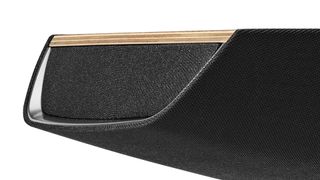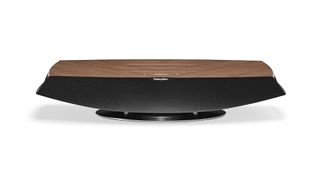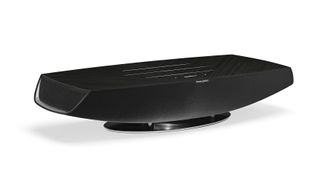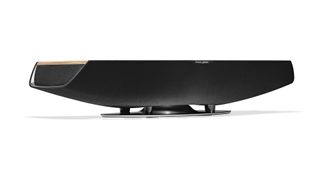Coming from a gene pool as strong as Sonus Faber’s, it’s little wonder the Omnia enters today’s all-in-one streaming wireless speaker market as one of the most beautiful (or should we say “bellissimo”) out there.
The Italian brand’s latest audio creation is more than a little reminiscent of its SF16 all-in-one speaker. That was a 2016-released homage to The Snail system that predated the company’s first-ever loudspeakers and was in fact the inaugural project by Sonus Faber founder Franco Serblin in 1980. The Omnia doesn’t have its eight-times-the-price predecessor’s extending ‘arms’ housing satellite speakers for the tweeters and midrange drivers, nor does it match its majestic size.
Instead, the Omnia is, as its price necessitates, a comparatively more modest affair – more or less in line with the crop of similar all-in-one systems (such as the Naim Mu-so 2) in terms of size and build.
- Naim Mu-so 2 vs Sonus Faber Omnia: which is the best wireless speaker system?
Design

Needless to say, it still determinedly embodies the classic Sonus Faber look, with its elongated, curvaceous shape and black grille and walnut wood exterior.
Like a labrador puppy in a pub on a Friday night, the Omnia demands attention (and, indeed, sometimes even petting) from our colleagues as soon as they walk in and clap eyes on it. That’s not only down to its classy walnut top panel but also the four light strips that decorate it. They act as a display of sorts: the shortest ‘control’ strip at the front illuminates in different colours to indicate the selected input (white is AirPlay 2; orange is HDMI; green is Spotify Connect, etc), while the two dots either side can be tapped to adjust volume (with the volume level indicated by the longer light strip above).
It’s all very satisfying, which is more than can be said for the remote. It’s a half-sized, shapely thing that feels pleasant but cheap in the hand; its flat rubber keys don’t offer you that positive click we want as feedback from each press. Due to the nature of this streaming-first product, though, it’s more likely that your phone will be your primary source of control, whether that’s using your phone’s physical operation or Google voice control through it.
Features

The Latin linguists will know that ‘Omnia’ means ‘prepared in all things’ (and now we do too – thank you, Google), and it’s a fitting name for such a versatile product. To some extent, streaming-savvy hi-fi has become a tick-box operation, with the list of available music services, file formats and transmission technologies only getting longer. While some manufacturers create their own app as a gateway to such services and as a way of accessing networked-stored music libraries, others, like Sonus Faber, have chosen to rely solely on user operation through native apps.
To that end, the Omnia supports AirPlay 2 for transmission from Apple devices; Google Cast for one-tap playback from several services such as Tidal, Deezer, YouTube Music, Apple Music, and Amazon Music on an Android device; and Spotify Connect. Tidal Connect (which defaults over Cast on Android devices) is also onboard and has the upper hand over Cast if you want to stream Dolby Atmos music or hi-res songs above 96kHz, although note that Omnia doesn’t actually support Atmos or the MQA technology behind Tidal’s hi-res ‘Masters’. Those wanting to access their NAS drive library will need to download a third-party DLNA app such as BubbleUPnP, or have a subscription to the Roon platform, which Omnia also supports.
Speaking of the decision to utilise established services in favour of its own control app, Sonus Faber’s Chief Designer Officer, Livio Cucuzza, said: “The customer knows how to use that, so keeping things familiar for their existing experience made sense to us.”
Living up to its name as determinedly as a Mr. Men character, the Omnia can also accommodate a TV through its HDMI ARC socket, as well as an audio source – including a turntable – through its dongle-like MiniDin switchable phono/line input adapter. It’s a little awkward to access these sockets around the back of the unit, but you’ll probably only have to do it once. Wireless connectivity doesn’t have to require an internet connection either, as aptX HD Bluetooth is also part of the Omnia's package.
Sound

Sonus Faber suggests giving the Omnia 10cm of clearance behind it and to the sides, and it’s advice we’d follow if you can. While you can select a ‘Near the wall’ setting in the Omnia’s web page-based set-up to help optimise balance, we certainly get the best tonal balance and airiest soundstage when the Omnia has a little room to breathe and isn’t closed in by walls. In fact, to deprive it its optimum placement is to sacrifice its biggest strengths.
Indeed, the Omnia is one of the biggest and most open sounding examples of its type we’ve heard. Close your eyes and you don't need to stretch your imagination to believe the sound is coming out of a pair of standmounters. That depth and breadth means instruments can work comfortably with space around them – even in denser mixes. And the Omnia impressively refrains from hardness or distortion at high (and even maximum) volume levels.
Size is also in the Omnia’s favour when it comes to bass reproduction, which impresses in quantity as well as quality. Kanye West’s Blood On The Leaves is a demanding track for any system to handle, with big, thumping bass lines, multiple musical strands to juggle and, to top it all off, Nina Simone’s sampled vocal to do justice to – but the Sonus Faber takes it in its stride. The horns and growls are potent and textured, and both West’s and Simone’s deliveries come through with decent doses of both substance and subtlety. The Omnia’s rendition is impressively clear and pure for a system of its sort, particularly through the mids.

Output 490 watts
Drivers x7
Connectivity Tidal Connect, Spotify Connect, aptX HD Bluetooth, AirPlay 2, Google Chromecast
Inputs Phono, line-level, HDMI
Nothing sounds as if it’s battling for room, as can often be the case with all-in-one systems, where multiple small drivers are inherently packed close together. Sonus Faber attributes this sonic achievement to its Crescendo technology, essentially processing that manipulates the 44mm side-firing cellulose pulp drivers to create as immersive and three-dimensional a soundstage as possible. Considering those side firers are accompanied by two 19mm silk dome tweeters, a pair of 75mm paper pulp cone midrange drivers and a 165mm long-throw aluminium cone woofer, all driven by a 490-watt amplifier, it’s little wonder the Omnia produces such a decent output.
Switching to the Naim Mu-so 2, we find ourselves more easily settling into the Naim’s tonal warmth and superior sense of musical cohesion. It demonstrates a tighter grip on the rhythm underpinning Aldous Harding’s Lawn, and its richer tone gives vocals a lovely honeyed sound. That said, we can’t help but miss the Omnia’s notably wider, more spacious soundstage and unrivalled clarity – and by no means is it a musical slouch itself. It’s lively enough and has a fine sense of drive, even if it isn’t the most rhythmically adept of the two.
Verdict

The strengths of both would combine to be the ideal system (wouldn’t it be nice to pick and choose like that?), but if you value openness and clarity and your listening habits are compatible with what the Sonus Faber has to offer, the Omnia is one of the finest of its kind you could hand over music duties to. And certainly the best looking, to our eyes.
SCORES
- Sound 5
- Features 4
- Build 5
MORE:
Read our review of the Naim Mu-so 2
Naim Mu-so 2 vs Sonus Faber Omnia: which is the best wireless speaker system?
Also consider the Bowers & Wilkins Zeppelin
These are the best all-in-one systems

